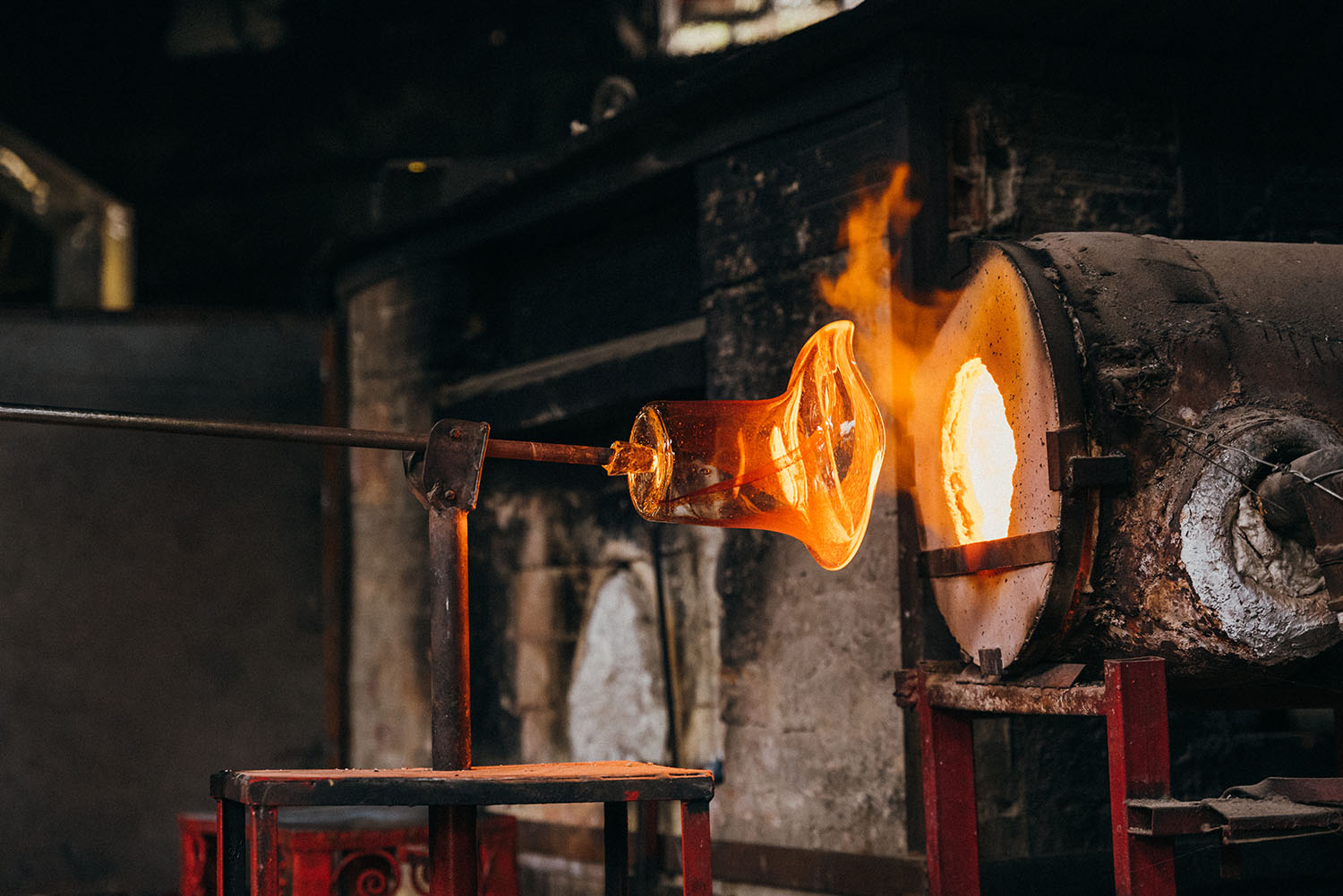The history of glassblowing

Glass blowing has been around for some time, invented by Syrian craftsmen more than 2,500 years ago. Their wares were primarily vessels for export to the Roman Empire – some shaped like heads, some were clusters of grapes, and some were fashioned after seashells. All of which we still see in today’s glasswork. And handblown glass is still produced in the same way it was produced when chariots were the transportation of choice.

HOW DOES GLASSBLOWING MAGIC HAPPEN?
Glass existed as a material prior to this, but no one had figured out how to turn it into a container. Molten glass (think molasses) is collected onto the end of a pipe and then inflated into a bubble. The glassblower then rolls the bubble on a smooth surface to shape it. Excess bits are cut off with shears or shaped with large tweezers, and protrusions such as legs and handles are added on – glass welding, basically. Hand blowing always leaves a pontil mark on the bottom, a quick way to authenticate the method. It’s a skill, a talent, an art – that has both evolved and remained the same over the centuries.

WHICH TYPE OF GLASS IS BEST?
The two most common types of glass used in glass working today are borosilicate, or hard glass, and soda-lime or soft glass. Soda-lime glass is the most common, while borosilicate is more difficult to work with but produces a far more durable and lightweight glass. Lead glass runs a distant third, although it was once very popular.
The difference between the glass types is the additives, or fluxes as they are called, primarily consisting of potash, sand, and limestone (among others).
Soda-lime (often referred to as ‘soda glass’) was the first to be invented and was improved and refined as it spread across Europe. The centre for luxury glass blowing in the 14th century was the island of Murano in Italy, and of course, Venice. The Nordic countries followed suit in the 15th and 16th centuries but keep in mind, glass items were still luxuries at this point and meant for the aristocratic class.

Lead crystal was developed by an Englishman in the middle of the 17th century and was widely used but for the most part was replaced by soda-lime glass in the early 19th century, when glassware became accessible to the masses. One of the most famous lead crystal houses, of course, is Baccarat, from France – established in the 1700s.
Borosilicate glass was first developed in Germany in the late 1800s, a relative newcomer, but in widespread use today. It is very resistant to temperature changes and can be used to hold hot or cold liquids, making it a very versatile glass.

GLASS BLOWING AROUND THE WORLD
Today, you’ll find master glassblowers in almost every country. Japan is emerging as a new kid on the block for high-end glass design, with Japanese works in many premier glass galleries, and in the homes of serious collectors worldwide. And Italy, of course, remains well-known for quality glassware as does the French glass industry. The epicenter of French glassblowing today is the medieval village of Biot, between Nice and Cannes, where many artists have studios. And there, you can combine a coastal French holiday with a glass blowing class – which sounds pretty good to us.
The art of glass blowing is beginning to enjoy some popularity as a hobby, (albeit a bit of an expensive one). It’s a learned skill, but a very rewarding one. Hobby glass blowing started slowly, in the 1960s, when the ‘Studio Glass’ movement emerged and introduced public workshops and various DIY studios for rent. And today, many studios offer one-off glassmaking classes (you’ll get to take your creation home) and some offer longer courses for those more serious about learning the craft.

PURCHASING HANDBLOWN GLASSWARE
When purchasing quality glassware or art glass, you should consider the aesthetics, the origin, and the type of glasswork. And always, what the intended purpose is. For example, handblown glass is always thinner and more delicate than machine-made glass – and is far nicer for drinking wine, among other beverages. The flavours are intensified, and the taste is enhanced with a delicate glass. And with hand-blown borosilicate glass, you get the delicate look and feel without the fragile nature of other glassware.

When it comes to something as complex as glass, you have to wonder what inspired that first Syrian craftsperson to invent the glass blowing pipe. Or to ever think that blowing molten liquid through a pipe would produce a balloon of glass that could hold liquids. Whoever they were, we are indebted to them for their creation. So, the next time you raise your glass to toast friends, family, or events in your life – give a silent thanks to those Syrian inventors, the architects of the modern glass.
SHOP THE COLLECTION




Commune Carafe | Fog Grey




Commune Carafe | Clear








Small Mock Rock Carafe | Strawberry








Small Mock Rock Vase | Strawberry
Related Posts
NOTES FROM THE FIELD: sourcing in morocco
Join us on our first Morocco sourcing trip, where founder Treana Peake set out to uncover true artisanship—beyond the souks, beyond the souvenirs, and into the heart of Morocco’s enduring craft traditions...
Morocco: The Story Behind our Camel Wool Blankets
Meet Hassan, a generational weaver from Fes, whose camel wool blankets carry his family’s legacy. Woven from one of Morocco’s most sustainable natural fibers, discover what makes camel wool so rare—and Hassan’s craft so remarkable...
From the Moroccan Desert to Your Skin: The Power of Prickly Pear Oil
Join us in the Moroccan desert, at the source of our coveted Prickly Pear Oil. Learn what makes prickly pear seed oil so special—from the harvesting process to the skin-healing benefits that have made it a cult favourite in Obakki Skincare...



